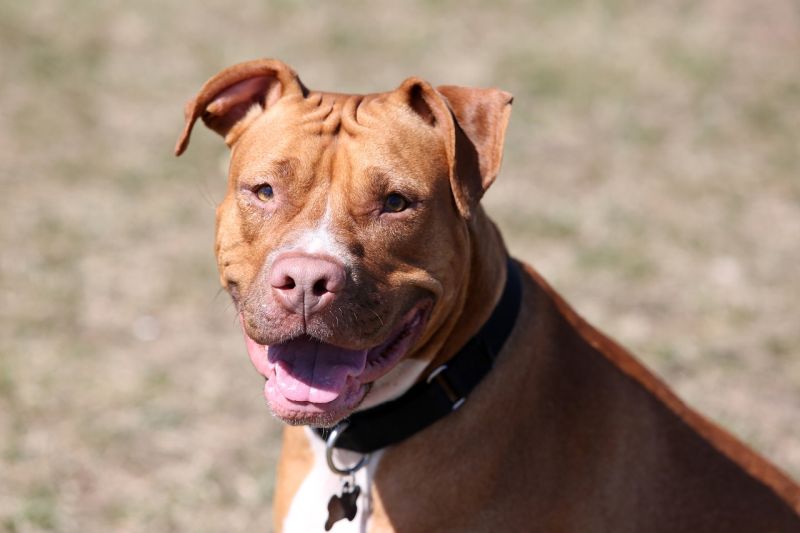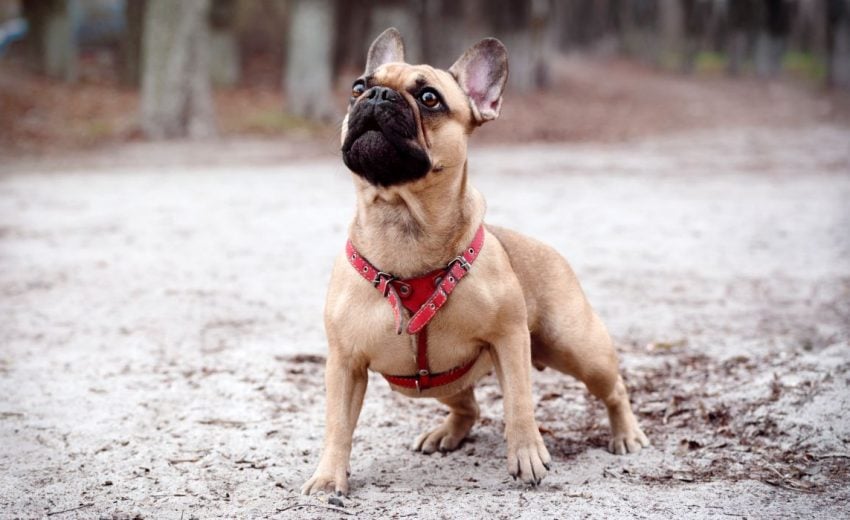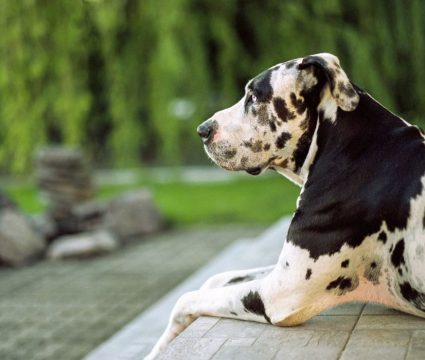Canine coats come in an array of beautiful colors and patterns, from jet black to marvelous merle. Today, we’re going to shine a spotlight on fawn-colored dogs and share 15 of our favorites!
Come check ‘em out!
What Color Is “Fawn,” Anyway?
Fawn is a shade of light brown, though in doggos, the color can range anywhere from soft tan to light reddish or yellowish-brown. Some people may also call fawn “blond” or “cream.”
Fawn dogs may have a black face mask around the muzzle, too, but not always.
The fawn color also resembles some other coat colors and patterns at times, and the word “fawn” is included in at least one other type of coat color. This unfortunately leads to some confusion among owners, but we’ll try to help you understand the differences between them all below.
How Is Fawn Different from Sable?


Sable is a coat pattern that involves black tipping at the ends of a dog’s individual hairs. But the hair on dogs with this color pattern may be somewhere in the sable portion of the color spectrum down by the root.
In practice, dogs with brownish fur are typically called fawn unless they exhibit black tips on the individual hairs. In these cases, the dogs are considered sable.
Both fawn and sable are dominant genes, controlled by the AY allele.
How Is Fawn Different from Brindle?


Fawn is a color whereas brindle is a pattern. Brindle dogs have a brown coat featuring dark chocolate or black swirls or striping in a distinct tiger-like look.
So, while brindle dogs can be brownish, they typically look quite different from dogs labelled as having a fawn coat (which does not include the swirls or stripes).
What Does Blue Fawn Mean?
Blue fawn refers to a diluted shade of gray or “blue,” as it’s known in the dog world. Blue fawn is also known as lilac or Isabella in dog fancier circles.
The blue fawn gene is, however, unrelated to the “typical” fawn gene and is located at a different locus. The blue fawn gene is situated on the D locus, while the conventional fawn gene is located on the A locus.
15 Awesome Fawn-Colored Dog Breeds
Now that we know what the fawn coloring is, let’s get to the good stuff! Here are some of our favorite fawn dog breeds:
1. French Bulldog

Fawn is common among Frenchies, a stocky companion breed with a personality as memorable as his bark. Always ready to play or cuddle, the Frenchie has taken the doggo world by storm. He’s an excellent family dog, though he can be stubborn, so first-time pup parents might find the breed challenging to handle.
He’s a breed well-suited for apartment living, as he requires limited exercise outside of a daily walk and indoor play. Frenchies have numerous health concerns and limitations, including an inability to swim well, breathing issues, and eye disease.
2. English Mastiff

These colossal canines come in many shades, including fawn. His short coat is easy to care with occasional brushing, but he does shed a fair amount. And for an extra-large dog his size, that fawn-colored hair can pile up quickly. Drool is another sticky point to consider.
While he was originally bred for guardian work, the English mastiff (like many mastiffs and mastiff-mixes) is now a much-beloved couch potato who enjoys leisurely strolls around the block and belly rubs. He can be a stubborn giant, however, so make sure he’s enrolled in obedience classes from an early age.
3. Chow Chow

Chows can be fawn, red, black, and blue — a color that also appears on his tongue! This Chinese dog breed’s thick coat comes in both rough and smooth varieties, with both having a dense undercoat. He sheds heavily as the seasons change and should be brushed daily around this time to remove loose clumps of hair, with special care around his mane where tangles may accumulate.
A member of the spitz family, the chow is highly intelligent, though he may sometimes think his way is best and ignore your commands. This stubbornness makes ongoing, positive training a must. He also has a tendency to distrust strangers, so work on socialization from an early age to prevent aloofness.
4. Great Dane

Fawn Great Danes are relatively common, though they also come in patterns like solid black, blue, and the eye-catching harlequin. His short coat doesn’t shed much, though at his size, fly-away hairs can accumulate quickly. This short, spiky hair also means he isn’t suitable for spending a ton of time outside in the dead of winter, so investing in a jumbo-sized jacket for walks is a good idea.
Great Danes make great family dogs, though they may be too large for romping around with small children. Daily walks and playtime are musts, though special care should be taken not to stress his joints too much as he’s growing. Bloat is a significant risk with this breed, so speak with your vet about the best feeding and watering practices.
5. Pug

A clownish canine that comes in fawn and black, the pug is a saucy little guy with a big personality. Fun is at the forefront for this companion breed, making him a wonderful dog breed for a busy family with children. While he’s active and playful, his exercise needs can be easily met through indoor play or a daily walk.
Since he’s a brachycephalic (flat-faced) breed, he struggles to breathe in extreme temperatures, so keep outside time at a minimum during the summer and winter. He’s also prone to ocular injuries and disease because of his large, protruding eyes.
6. American Pit Bull Terrier

Fawn is one of many shades found in American pit bull terriers. His close-cropped glossy hair is easy to care for, with shedding typically remaining mild and easily controlled through occasional brushing. Allergies are a concern for him, however, so keep a close eye on his skin for signs of redness or itching.
He is devoted to his family but will need early positive exposure to new people and animals to avoid aloofness. He’s well-known for his working drive and energy, which lend well to canine sports, like agility and flyball.
7. Dogue de Bordeaux

These pouty-faced pups come in four colors: fawn, red, mahogany, and Isabella. Expect some hair around the house with a dogue, as he’s definitely not a low-shedding dog breed. His personality-filled wrinkles and jowls require occasional cleaning to keep skin irritation and drool at bay, too. Other than that, his handsome appearance is relatively low maintenance.
The dogue is a great family dog, but his large size may be an issue with small children around, as sometimes he forgets his size. Dogues are one of the easier mastiffs to train, though always keep learning positive and reward-based to avoid upsetting his sensitive soul.
8. Perro de Presa Canario

A regal mastiff that comes in fawn, silver, brindle, and beyond, the presa isn’t super common stateside. A working dog at heart, he loves to put his powerful body to work, whether he’s helping around the farm or joining you on a hike. He’s not a dog for inexperienced owners, as he can and will test the limits as he sees fit. This makes ongoing training and socialization regimens musts.
Outside of training and exercise, the presa is a relatively easy keeper, with limited grooming needs aside from occasional brushing and ear cleaning. Your presa may also drool, particularly after a trip to the water bowl, so keep a cloth handy for wiping as needed.
9. Boxer

The bouncy boxer can be in many colors, including fawn. Always down for a game of backyard ball or a hike, he’s a happy-go-lucky pup who thrives in family environments. This deep attachment to people can lead to misbehavior if he’s left alone too much, so make sure your boxer buddy gets plenty of one-on-one time. He needs daily exercise, too, and he is a prime candidate for a doggo sport, like agility.
The boxer is relatively easy to train and a superior choice for first-time dog owners (especially those with babies or young kiddos). Keep his training upbeat, and you’ll be rewarded with a sweet, people-pleaser of a pooch with an arsenal of cool tricks.
10. Shar-Pei

A wrinkly pooch with a rainbow of color options, like fawn, apricot, and red, the Shar-pei is a unique face in the dog world. His short coat needs little upkeep, though his folds and ears should be cleaned frequently to prevent irritation. He sheds regularly, too, so he might not be the best pick for allergy sufferers.
He’s a loyal and laid-back, low-maintenance dog breed, but he can be quite independent, leading to bouts of stubbornness that can be legendary. Paired with an aversion to strangers and new dogs, he’s a less than ideal choice for newbie dog owners.
11. Saluki

Fawn is one of many colors you’ll see in this elegant sighthound. His beautiful coat comes in both smooth and feathered, with the feathered variety recognizable by its silky ears and wispy long ends called “feathers.” The saluki’s coat is easy to care for, though feathered salukis will need regular ear and feather combing to prevent tangles.
Like all sighthounds (who were initially developed as hunting breeds), your saluki should never be trusted off-leash as he’ll bolt after any temptation, whether it’s a squirrel or your neighbor’s cat. His sensitive, sweet nature is one of his best qualities, though it should be taken into consideration during training to prevent hurting his feelings.
12. Anatolian Shepherd

This loyal livestock guardian’s fawn coat ranges from short to medium-length. Both coat types experience heavy seasonal shedding and need extra brushing sessions to remove loose tufts of hair. The Anatolian’s working origins are best-suited for a home with a good amount of fenced-in land to roam, though daily walks can also satisfy his exercise needs.
While he’s a prized pooch, he has a strong personality that requires an experienced owner. His first instinct is to protect, meaning he’s not the most accepting of strange dogs or people. Early socialization and training are needed to help steer him in the right direction.
13. Chihuahua

Chihuahuas are pint-sized pups (typically considered the smallest breed in the world), who come in a variety of colors, including fawn.
While he’s small in size, he’s packing a gigantic personality, with a sassy nature that rivals dogs far larger than he is. He’s a wonderful lapdog, but he’s also happy to engage in play, making him a favorite in families with older children.
The Chihuahua (as well as Chihuahua mixes) works well in apartment settings, with a daily walk satisfying his exercise needs. Like other toy breeds, brush his teeth regularly to keep his chompers nice and healthy since he’s prone to dental issues.
14. Bullmastiff

Fawn is one of many colors seen on the bullmastiff, a mighty molosser whose short coat only needs occasional brushing. His massive head features a short snout that makes an air-conditioned environment a must, as he’s not a dog breed well-suited for warm weather. Those adorable facial folds also require special attention to remove any debris that can cause skin irritation.
He’s a large, powerfully built dog who needs consistent training from puppyhood on. While he’s happy to listen to commands, he isn’t always eager to meet strangers, so incorporate plenty of socialization with new people and pets.
15. Italian Greyhound

Coming in all colors and patterns except for brindle and black and tan, the Italian greyhound is a short-haired pooch with a sensitive spirit. Also known as the Iggy, the Italian greyhound is an affectionate little guy who loves nothing more than curling up with his favorite person. This delicate nature makes positive, reward-based training a must.
Iggies are prone to dental issues, and regular tooth brushing is needed to keep his pearly whites in tip-top shape. His short coat is also a concern in colder climates, as these are not dogs breeds who thrive in cold weather. So, stock up on doggy sweaters once the weather changes.
***
Do you share a home with a fawn-colored Fido? Is it one of the ones on our list today? Another? Let us know in the comments!








2 Comments
March 26, 2023
My American Akita has fawn coloring to her white base coat. I have no idea which has the more striking coloring, her or my blue Merle Catahoula.
March 27, 2023
They both sound gorgeous, Adam!